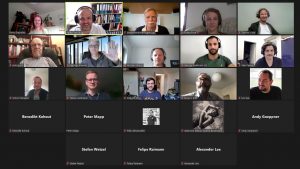
The sound particle diffraction method is a new calculation approach for room acoustics that SoundPLAN has been working on for more than seven years. It was developed in cooperation with a research institute. Starting with concepts of currently used calculations for room acoustics, Thomas described the background of the simulation method including the advantages in dealing with diffraction.
The propagation of sound is based on wave physics. Even if the performance of modern computers is increasing rapidly, the use of wave physics simulation models requires a lot of memory and calculation time, especially at high frequencies. Therefore, ray-tracing models are used. They are based on a geometric approach in which rays are reflected at boundaries. The sound field at a receiver position results from the sum of the direct sound and the reflections. Due to the calculation approach, these models cut out important properties of wave physics like diffraction.
In a model based on the sound particle method, the source does not emit rays but particles. Depending on the reflection structure, the particles create a distribution that defines the sound field. The approach includes sound emission, specular reflection, diffuse reflection, scattering, transmission, detection and a new diffraction method. Uncertainty-based diffraction calculates the angle of deflection as a function of the distance of a particle to a boundary. This approach provides results that are more accurate than the commonly used diffraction methods and a model that is closer to wave physics.
Thomas pointed out tips for geometrical acoustic modelling related to the level-of-detail required for a particular simulation purpose and an analysis of uncertainties, which are of great importance in practical work. The influence of different simulation methods on the results of room acoustic parameters was discussed. Finally, he opened topics for further research and potential for new simulation methods in indoor and outdoor environments.
We thank Thomas for the very nice presentation, which offered a great balance between the basic, mathematical background and the practical application. It has shown very nicely the connection between acoustics and sound engineering. Two fields that show a lot of overlap and whose results could benefit from a more intensive exchange between the experts.
A video of the presentation is available on YouTube.
